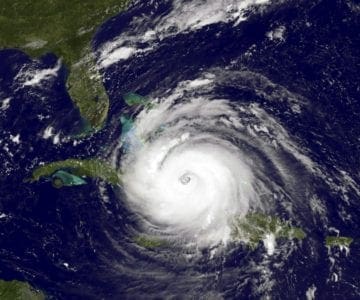We are now in the middle of the hurricane season that could produce storms that could drop up to 30+ inches of rain. It is a good time to discuss with your drivers about flooding and the fact that road conditions can change rapidly with flash floods.
 Each year, more deaths occur due to flooding than from any other thunderstorm related hazard. Why? The main reason is people underestimate the force and power of water. Over half of all flood related deaths each year occur with victims inside vehicles. Many of the deaths occur in vehicles as they are swept downstream. Of these drownings, many are preventable, but too many people continue to drive around the barriers that warn you the road is flooded.
Each year, more deaths occur due to flooding than from any other thunderstorm related hazard. Why? The main reason is people underestimate the force and power of water. Over half of all flood related deaths each year occur with victims inside vehicles. Many of the deaths occur in vehicles as they are swept downstream. Of these drownings, many are preventable, but too many people continue to drive around the barriers that warn you the road is flooded.
Even when operating a large commercial motor vehicle you can be swept away by the strong force of the waters current. I remember vividly watching a number of years ago a cement mixer which had been caught in a storm water canal in Los Angeles during a flash flood be swept down the canal as if it were a toy boat. To check on weather conditions and flooding, go to the National Weather Service website by Clicking Here.
Whether you are driving or walking, if you come to a flooded road, Turn Around Don’t Drown. You will not know the depth of the water nor will you know the condition of the road under the water.
- If flooding occurs, get to higher ground. Get out of areas subject to flooding. This includes dips, low spots, canyons, washes etc.
- Avoid areas already flooded, especially if the water is flowing fast. Do not attempt to cross flowing streams. Turn Around Don’t Drown
- Road beds may be washed out under flood waters. NEVER drive through flooded roadways. Turn Around Don’t Drown If your vehicle is suddenly caught in rising water, leave it immediately and seek higher ground.
- Don’t park your vehicle along streams and washes, particularly during threatening conditions.
- Be especially cautious at night when it is harder to recognize flood dangers.
- Avoid low water crossings.
- Use alternate routes to avoid flood prone areas.
- Leave your vehicle immediately if it stalls in flood waters.
- Move to higher ground if you can do so safely.
- Most cars and light trucks will begin to float in as little as 1 to 2 feet of water.
- DO NOT ASSUME YOU ARE SAFER DRIVING THROUGH WATER IF YOU DRIVE A “BIG TRUCK” THAT IS HIGHER OFF THE GROUND.
Originally Posted on the Idealease Safety Seminar

